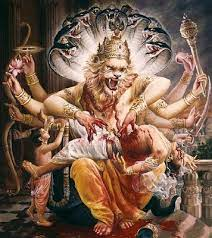The Creator
Kasyapa had two demoniac sons named Hiranyaksha and HiranyaKasipu, and a
daughter named Simhika through his wife Diti.
Once the elder brother
Hiranyaksha got boons from the Creator Brahma and roamed about as a very
valiant hero destroying everything on the earth and finally pulling down the
earth to the depths of the ocean.
Mahavishnu then incarnated as Varaha-the wild boar, killed Hiranyaksha,
lifted the earth from the ocean and placed it in its original position.
Later, HiranyaKasipu
became very angry at Mahavishnu for killing his elder brother Hiranyaksha. He performed penance to propitiate Brahma,
with a view to wreaking vengeance on Mahavishnu.
When HiranyaKasipu went
the forest to do penance, the Devas attacked the regions of the Demons. In that Great War the Devas were
defeated. While feeing away, Indra took
away Kayaadhu the pregnant-wife of HiranyaKasipu by force.
The Divine sage Narada
who heard the moanings of the poor woman under the clutches of Indra, got her
released from Indra’s hold. For some
time she stayed in the Asrama of Narada worshipping him. Narada taught the child in Kayaadhu’s womb lessons
in Vedas, moral philosophy, duty and spiritual knowledge.
When HiranyaKasipu
returned after his penance, Kayaadhu joined him and very soon gave birth to a
son. The boy was named Peahlada. HiranyaKasipu decided to make Prahlada an
instrument to wreak vengeance on Mahavishnu.
Entrusting the education of his son to able preceptors, he instructed
that the boy should never mutter “Naaraayanaaya Namaha”, but should on the
other hand mutter “Hiranyaaya Namaha” only.
Not only that, HiranyaKasipu wiped out the name of Narayana from the
land altogether.
Prahlada stayed in the
preceptor’s house and studied his lessons. One day Prahlada went to see his
father along with his preceptors. The
affectionate father asked him to repeat the good things that he had learned so
far. The intelligent Prahlada who had
acquired the knowledge already when he was in his mother’s womb, immediately
repeated, “I bow down to Mahavishnu, the root cause of all things seen and
unseen, beginning, center and end of all the things and who is without origin,
growth and decay.
On hearing
this, the irritated HiranyaKasipu, somehow managed and politely asked him not
to do so. But Prahlada refused and repeated the same. Then enraged
HiranyaKasipu ordered his attendants to kill his own son by all means, but he
failed always.
As days went by, HiranyaKasipu got wild again and he
could not bear Prahlada’s increasing devotion to Mahavishnu. Once Prahlada was repeating the same, HiranyaKasipu
jumped up from his thrown with sword in his hand asked Prahlada where is
Vishnu.
Vishnu very calmly replied that Vishnu was present
everywhere even in stones, trees or the pillars of the palace. HiranyaKasipu in uncontrollable anger, struck
the nearest pillar with his sword. Then
to the shocking surprise of HiranyaKasipu, Mahavishnu in the form of a fierce
man-lion (Narasimha) jumped out from the pillar and jumped on the body of
HiranyaKasipu and tearing him with his nails and brought him to end.
Everything happened in no time and the Narasimha changing into the form of Mahavishnu for the sake of Prahlada, blessed him and disappeared.
(This is a part of Blogchatter's Half Marathon 2023)





Hiranyakashyap and Prahlad's mythological tale is a timeless representation of good versus evil. Prahlad's unwavering devotion and Hiranyakashyap's arrogance showcase the eternal struggle between righteousness and ego. This story beautifully conveys the triumph of faith and virtue, making it a captivating lesson for all generations.
ReplyDeleteYes it is.
Delete